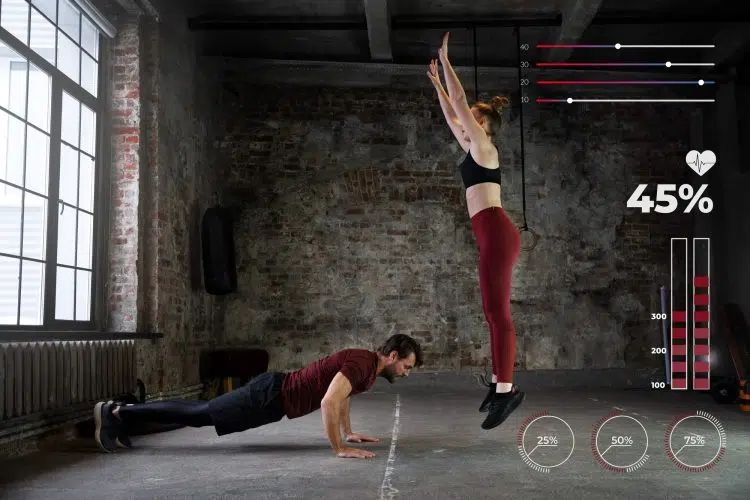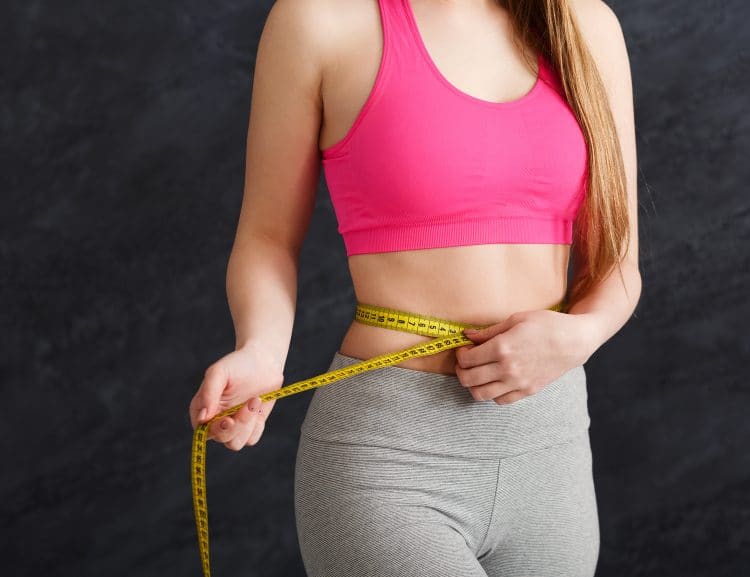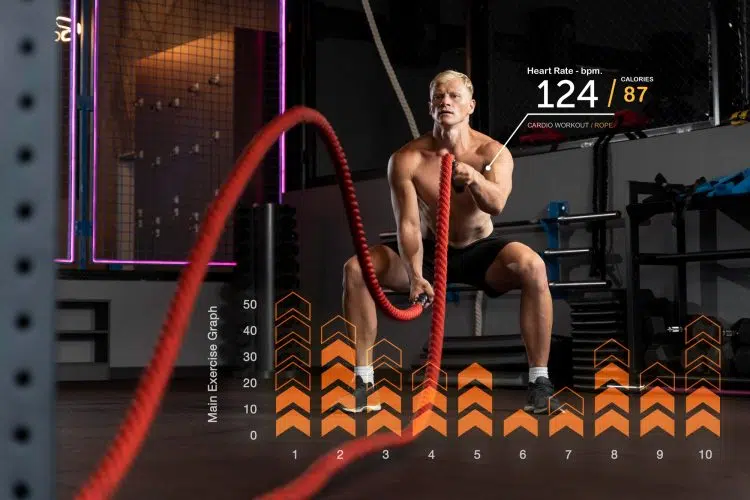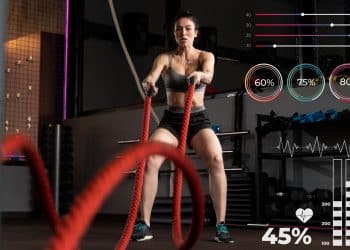Many people question the effectiveness of their exercise routines. The Fitness Age Calculator provides valuable insight into overall fitness by estimating fitness age based on key health and lifestyle metrics.
Fitness Age Calculator
Your Fitness Age:
Chronological Age:
Recommendations:
Health Tips:
- Stay hydrated and drink plenty of water.
- Get enough sleep and maintain a regular sleep schedule.
- Incorporate both cardio and strength training exercises into your routine.
- Eat a balanced diet rich in fruits, vegetables, lean proteins, and whole grains.
Understanding the Fitness Age Calculator
A Fitness Age Calculator compares your body’s fitness level to age-specific norms using data like resting heart rate and physical activity level. This scientifically-validated tool assesses whether your body functions biologically younger or older than your chronological age.
What is Fitness Age?
Fitness Age quantifies how well your body functions compared to typical fitness levels for your chronological age. It analyzes factors such as resting heart rate, body composition, and physical activity to determine biological age variance.
Research indicates that a significantly older Fitness Age may correlate with increased early mortality risk. For example, a study of Senior Olympians found their average chronological age was 68, while their Fitness Age averaged 43 – demonstrating how an active lifestyle can yield a 25-year biological advantage.
A lower Fitness Age correlates with improved cardiovascular health and longevity.

How the Calculator Works
Originally developed by scientists at the Norwegian University of Science and Technology, the Fitness Age Calculator utilizes an algorithm incorporating height, weight, resting heart rate, physical activity, smoking status, and diet quality. This data estimates VO2 max – a crucial indicator of cardiovascular fitness and aerobic endurance – to determine overall fitness age.
Level Up Your Fitness: Join our 💪 strong community in Fitness Volt Newsletter. Get daily inspiration, expert-backed workouts, nutrition tips, the latest in strength sports, and the support you need to reach your goals. Subscribe for free!
Key Metrics Used by the Calculator
Gender, Age, Weight, Height, Resting Heart Rate, Smoking Status, Diet Quality
Each metric contributes uniquely to fitness age calculation:
- Gender: Accounts for physiological differences in body composition and metabolic rates
- Age: Baseline for comparing individual fitness to age-specific norms
- Weight and Height: Determine Body Mass Index (BMI), influencing cardiovascular health
- Resting Heart Rate (RHR): Lower RHR indicates superior cardiovascular efficiency
- Smoking Status: Reflects potential cardiovascular impairment
- Diet Quality: Assesses nutritional impact on overall physical well-being
VO2 Max Estimation
VO2 Max estimation is crucial for Fitness Age calculation. It measures maximum oxygen utilization during intense exercise, reflecting cardiovascular health and aerobic endurance. Higher VO2 Max correlates with improved cardiorespiratory fitness and reduced chronic disease risk, including heart disease and dementia.
Aerobic fitness predicts longevity more accurately than other health markers.
Physical Activity Level
Physical activity significantly influences fitness age. Regular exercise enhances cardiovascular and respiratory function, increasing VO2 Max and overall fitness. Activities like running, swimming, and cycling improve oxygen utilization and mitigate health risks associated with sedentary lifestyles.
Waistline Measurements

Waistline measurements provide critical health risk insights. Measure at navel level for accuracy. Larger waist circumference may indicate increased risk for conditions like non-alcoholic fatty liver disease and cardiovascular issues, negatively impacting fitness age.
Scientific Formulas Used in the Calculator
The Fitness Age Calculator employs established formulas:
- Karvonen Formula: MaxHR = 208 – (0.7 x age)
- VO2 Max Calculation: VO2 max = 15.3 x (MaxHR / RestingHR)
VO2 Max Averages
Typical VO2 max averages by age and gender:
| Age Group | Males (VO2 max) | Females (VO2 max) |
|---|---|---|
| 20-29 | 47 | 41 |
| 30-39 | 43 | 37 |
| 40-49 | 41 | 35 |
| 50-59 | 38 | 33 |
| 60-69 | 34 | 29 |
| 70-79 | 30 | 26 |
Fitness Age Formula
The calculator uses the following formula:
Fitness Age = Chronological Age – 0.2*(VO2 max – VO2 max average)
Benefits of Knowing Your Fitness Age

Understanding your fitness age provides valuable insights into bodily function and potential health risks. It identifies areas for improvement, motivates healthier habits, and enables progress monitoring, thereby reducing chronic disease risk.
Health Risk Assessment
Knowing your fitness age facilitates early health risk detection. High fitness levels can reduce premature death and heart disease risk by 40-50%, lower sudden cardiac event likelihood, and decrease cancer incidence. Fit individuals have up to 15% lower prostate cancer risk and reduced dementia-related mortality.
Personal Fitness Tracking
The Fitness Age Calculator enables precise personal fitness monitoring. It provides a baseline for improvement and guides progress in key metrics like resting heart rate, weight, and VO2 Max. Regular reassessment reveals the effectiveness of exercise and dietary interventions, transforming abstract goals into measurable outcomes.
Conclusion
The Fitness Age Calculator serves as an effective tool for comprehensive fitness assessment. By analyzing factors such as resting heart rate, diet quality, and physical activity levels, it provides an accurate measure of fitness age. Regular utilization of this tool facilitates progress tracking and motivates sustained healthy lifestyle choices.
References
- Karvonen, M., Kentala, E., & Mustala, O. (1957). The effects of training on heart rate; a longitudinal study. Annals of Medicine and Experimental Biology.
- Astrand, P.O., & Rhyming, I. (1954). A nomogram for calculation of aerobic capacity (physical fitness) from pulse rate during sub-maximal work. Journal of Applied Physiology.
- Cooper, K. H. (1968). A means of assessing maximal oxygen intake: Correlation between field and treadmill testing. Journal of the American Medical Association.
- American College of Sports Medicine. (2018). ACSM’s guidelines for exercise testing and prescription (10th ed.). Wolters Kluwer.
- Nes, B. M., Janszky, I., Vatten, L. J., Nilsen, T. I. L., & Aspenes, S. T. (2013). Estimating V̇O2peak from a nonexercise prediction model: The HUNT Study, Norway. Medicine and Science in Sports and Exercise.
- Nes, B. M., Vatten, L. J., Nauman, J., Janszky, I., & Wisloff, U. (2014). A simple nonexercise model of cardiorespiratory fitness predicts long-term mortality. Medicine and Science in Sports and Exercise.
- Aspenes, S. T., Nilsen, T. I. L., Skaug, E. A., Bertheussen, G. F., Ellingsen, Ø., & Vatten, L. J. (2011). Peak oxygen uptake and cardiovascular risk factors in 4631 healthy women and men. Medicine and Science in Sports and Exercise.
- Blair, S. N., Kohl, H. W., Paffenbarger, R. S., Clark, D. G., Cooper, K. H., & Gibbons, L. W. (1989). Physical fitness and all-cause mortality: A prospective study of healthy men and women. JAMA.
- Biddle, S. J., & Asare, M. (2011). Physical activity and mental health in children and adolescents: A review of reviews. British Journal of Sports Medicine.
- U.S. Department of Health and Human Services. (2018). Physical Activity Guidelines for Americans (2nd ed.).









Hey Andy,
Great site here. Very informative. Thanks for sharing